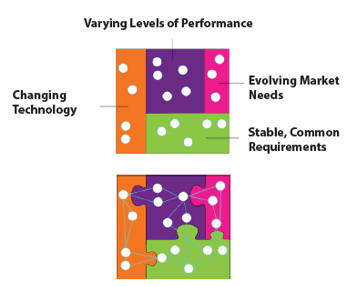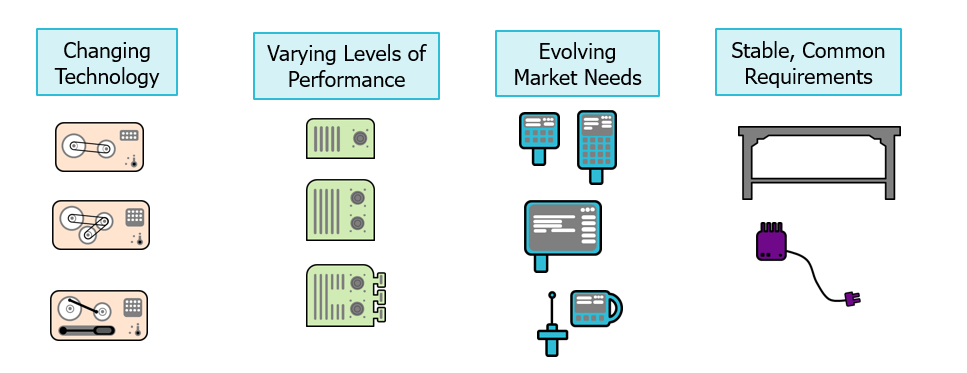Does your Product Design Methodology Support your Company Strategy?
Most companies today are operating in multiple market segments and regions where customers demand unique products customized to their preferences with a steady stream of new features and performance. Companies are also looking across their established internal silos to find ways to improve the performance of their organization. The challenge is to simultaneously meet the market demand of mass customized products while cutting internal costs, complexity, lead times and time to market.
There is often a mismatch between a company’s market realities, their own strategy and their approach to product design. All design approaches aim to optimize the solution, but the objectives of the optimization process are not the same. The company wants to maximize their use of resources, increase profitability and be agile in response to the markets, but the results are not sustainable.
One key reason is that companies are stuck in a product development loop that uses a traditional design methodology, optimizing each solution around a specific customer or market segment with a narrow range of performance, features and price. Individually, each development will likely achieve its objectives. But taken collectively and over time, the result is a series of integral architectures which are inefficient, hugely complex and not sustainable. Modular design uses an optimization methodology that embraces broader product development and strategic company objectives to produce a solution that is both efficient and agile over time. The resulting intentionally created product architecture is a sustainable asset that will meet customer needs across market segments with a steady stream of new features and performance with less complexity and at a much lower total cost.
Understanding the key tenants of traditional design versus modular design will give you insights on how the objective of each method produces a different type of architecture. Which optimal solution best supports your company strategy?
Traditional Design Leads to Integral and Intertwined Architectures
In traditional product design, product management or sales translates the customer request into a description of the desired attributes of the new product, and the company establishes a cost target. Consequently, the objective of the product development team as documented by Marples (1961) and Alexander (1964) is an “optimized design that provides either (1) a defined set of attributes and performance levels at the lowest possible cost, or (2) the highest possible performance levels for a set of attributes achievable within the constraint of the target cost.”1 This means that the team works to achieve the lowest cost while meeting the performance specification or they meet the target cost while achieving the best performance level.
To achieve these objectives, Ulrich and Seering (1990) state that the product development team will “typically create a complex product design that incorporates assemblies of interdependent functional components whose designs have been integrated to achieve the lowest possible cost or the highest possible level of performance for the product.”2
This optimization methodology results is an integral architecture where the components are highly intertwined.
The need for additional products to meet other performance levels, price points or regional preferences leads to a sequential series of product development derivatives, with new components that are similarly intertwined into each new product. Over time, most companies create numerous product families comprised of many product variants.

The result is hundreds of top-level assemblies and many thousands of unique part numbers. Sustaining this level of complexity is hugely expensive. Changes to the products are inevitable to react to new market needs, keep up with technology evolution and stay ahead of vendor obsolescence. To combat this complexity, many companies attempt to standardize parts across product families. But with an integral architecture, changes to single components cannot be done in isolation. As changes propagate across the products, the intertwined components cause one engineering change to turn into many. Sanchez (1999) says that the complexity of these changes grows exponentially with the number of unique part numbers and products making the task inordinately difficult, costly, and time-consuming. 3
Modular Design for Agility and Flexibility
The optimization methodology of modular design incorporates a broader scope of the customer needs (often multiple market segments and regions) and an objective for total product portfolio profitability rather than cost that is viewed narrowly, product by product. It also embeds a strategic intent of how the resulting architecture will enable changing customer needs and required innovation to deliver new products over multiple generations.
The key tenants of modular design are to isolate the interdependence between components then optimize based upon the objectives of the entire product portfolio rather than product by product, balancing complexity with needed flexibility.
It achieves this by first identifying the underlying product functions needed and

These building blocks are modules when the interfaces between them are standardized.
With stable, standardized interfaces, market-driven variants of these modules are developed to add price or performance levels, meet new market needs or adapt to new technology without redesigning the entire product.
A modular product architecture allows the free exchange of modules to efficiently provide a vast range of products.
New and existing module variants can be combined into a large family of products, while keeping the number of new components to a minimum. Modular design produces a modular product architecture that vastly decreases your cost in multiple ways and assures you get the most out of efforts to expand your product family portfolio, introduce new technology and optimize production.

Why you Should Choose a Modular Design
Traditional design can be effective in narrow markets where customers demand little or no variance in the product, and it is stable over time. It is also often the best method to achieve break-through performance in a new market where there is an extremely high technical challenge. Since bringing the first product to market can often be accomplished faster and with fewer resources, many companies default to the traditional design method. However, this advantage is quickly lost as the product portfolio expands and is maintained over time.
Modular design is a larger scope, up-front investment which requires a higher level of discipline, broader engagement of company resources and may take a little longer to bring the first product to market. However, this investment soon yields new additions to the product family with shorter time to market, less complexity and lower costs. Companies who choose modular design have determined that their strategy is best aligned with a design methodology that optimizes around the objectives needed for long term sustainability and agility.
How do you implement Modular Design in Product Development?
Modular Design has the potential to deliver tremendous benefits for a company. But achieving an optimal product architecture is not a trivial task and not an endeavor assigned to and executed by the engineering team alone. It is a highly cross functional activity that must employ a robust methodology. Modular Function Deployment® (MFD®) is a proven method that has been used to execute modular design for over 25 years. In this guide we'll walk you through the 5 steps to create a Modular product Architecture using the Modular Function Deployment method.
 Luther Johnson
Luther Johnson
President
Modular Management North America
luther.johnson@modularmanagement.com
+1 952 854 6800
References
1) Marples (1961) and Alexander (1964)
2) Ulrich and Seering (1990)
3) Sanchez (1999)



